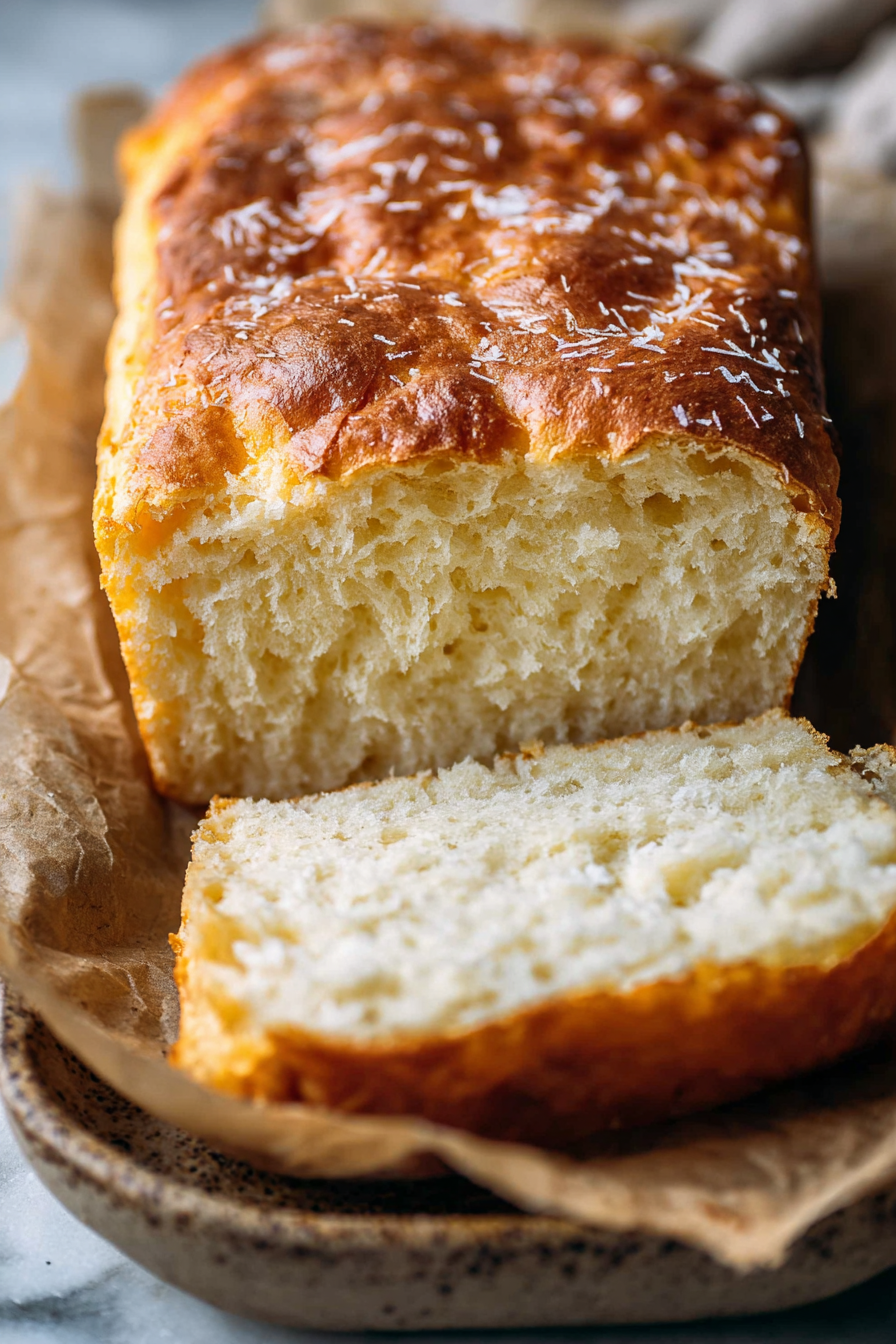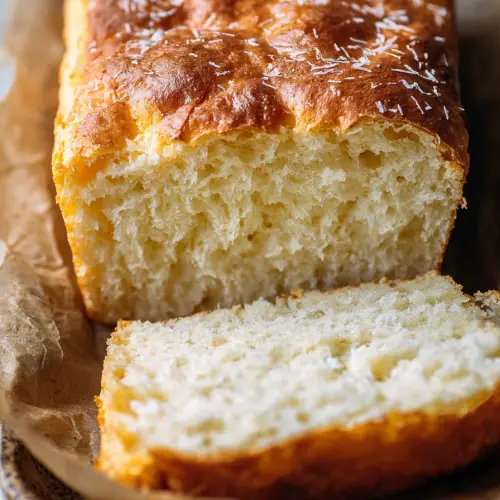Easy Butter Swim Bread Recipe

There are certain recipes that feel like an old sweater: instantly comforting, a little frayed around the edges, and perfectly suited to slow mornings. I call this one Easy Butter Swim Bread Recipe at home, and it’s the sort of loaf that smells like warm butter and a hint of caramel the second it comes out of the oven. It’s not fussy; it’s all about simple, generous fat bathing the crumb until it’s glossy and tender. Honestly, if you like bread that wants to be eaten right away with your fingers and a mug of coffee, this will become one of those go-to cozy things.
My husband is a quiet breakfast person—he likes to sit, slowly wake up with steam curling from his cup. The kids, on the other hand, are sprinting into the kitchen with socked feet and requests that sound like song lyrics. One Saturday, I slid this loaf into the oven while an old jazz record played low in the corner. Our dog, who believes the oven is a kind of altar, stationed himself by the oven door and maintained very serious eye contact. The first slice came out slightly uneven because someone (ahem, me) leaned in too close to cut while balancing a half-drunk cup of coffee. We laughed, someone buttered their piece upside-down, and the kitchen filled with the small, sticky sweetness of browned butter. The payoff was quiet and ridiculous and perfect—a table with crumbs, warm smiles, and the kind of domestic contentment that makes you want to stay in pajamas all afternoon.
MORE OF OUR FAVORITE…
Why You’ll Love This Easy Butter Swim Bread Recipe
– It smells like home right from the oven: browned butter, a whisper of caramel, and the kind of toasty smell that makes everyone wander into the kitchen.
– The texture is tender and slightly yielding—soft enough to sink into but with a crust that gives a satisfying little crack when you pull a slice.
– It’s forgiving. I’ll admit I’ve baked it with different flours, a lazy fold or two, and even while answering a hundred tiny questions from children, and it kept showing up comforting.
– It’s flexible in mood: great for a slow weekend brunch, decadent enough for company, but humble enough for a midweek “we deserve this” breakfast.
– The visual payoff is cozy and golden—glossy butter pooling in the nooks and a loaf that looks like it’s wearing a warm blanket.
Slow Moments
There are small rituals I always treasure when I make this loaf. I like to stand at the counter with a wooden spoon, stir a little more deliberately than strictly necessary, and taste the batter with a fingertip—always too hot, but somehow worth it. The kitchen light in late autumn hits the counter at an angle that makes everything seem softer; you can watch the butter melt into the batter and think about nothing at all and about everything at once. Sometimes a child will run through carrying a stuffed animal and sweep crumbs onto the floor like confetti. Other times, my husband hums an off-key line of an old song. I let the oven do its steady work and pay attention to the small sounds: the click of the timer, the soft creak of the mixer, the dog’s gentle sigh when a crumb falls. Waiting for the loaf to cool is its own gentle lesson in patience; the inside needs a minute to settle so the texture is exactly as it should be—tender, slightly yielding, and gloriously buttery.
Time-Saving Hacks
– Use room-temperature butter and ingredients so things come together faster; it shortens mixing time and gives you a more even crumb.
– If mornings are frantic, mix the batter the night before and keep it covered in the fridge; bring it out to rest while the oven warms—this isn’t fussiness, it’s a civilized way to steal time.
– Swap a stand mixer for a sturdy wooden spoon and a little muscle; it’s slower but oddly calming, like you’re doing something that matters.
– Keep a small jar of browned butter in the fridge for the week; warming a spoonful before you bake adds instant depth and saves an extra step.
– A calm reminder: the loaf benefits from slow, steady heat. Rushing to blast it at a higher temperature often gives you crust before the inside is ready. Slowing down helps.
Serving Ideas
– For a simple weeknight: slice warm, spread with a smear of jam or a drizzle of honey, and pair with black tea or a mellow coffee. The contrast of sweet and buttery is gentle and perfect.
– For a slow weekend: add a soft scrambled egg, a handful of wilted greens, and a drizzle of good olive oil; breakfast becomes a little celebratory without being fussy.
– For guests: serve with a small board of cultured butter, lemon curd, and a bowl of seasonal fruit—watch the conversation orbit the food softly.
– Pairings: this loaf loves nutty cheeses, a tart chutney, or simply a sliver of salted butter that melts into the nooks. It’s also a calm companion to porridge or a bright citrus salad on the side.
Tips & Mistakes
I once tried to save time by using butter that was still a touch cold. The result was a loaf that had odd pockets and a crumb that was just a little too dense. Lesson learned: patience with temperature is kindness to texture. Also, don’t overmix. I’ll admit I have a tendency to stir until everything feels “done,” but that usually ends with a tougher crumb. Fold with intent, and stop when things look gathered and smooth—not perfect. Another thing: watch the butter pooling. If you overdo it, the top can get a little slick; it won’t ruin the bread, but it changes the mouthfeel. It’s all forgiving, though—this is a recipe that lets you laugh at minor missteps and still have a beautiful, comforting slice.
Storage Tips
Leftovers keep beautifully. Wrap the loaf in a clean tea towel and place it in a bread box or a paper bag at room temperature for a day or two; it stays tender and cozy. If you refrigerate, slice what you want and bring the rest to room temp before serving—that helps recover some of the buttery softness. I love slightly warm leftover slices: a quick turn in a warm, dry skillet or a minute in a low oven revives the crust and makes the inside pillowy again. Cold is also fine with a strong cup of coffee in the morning; some days, a chilled slice with coffee feels like a calm, indulgent secret.
Variations and Substitutions
I’ve folded in a few things over the years. A touch of citrus zest—lemon or orange—brightens the butter and lifts the whole loaf. A handful of toasted nuts or a sprinkle of flaky sea salt on top adds texture and that delicious contrast of sweet and savory. Whole wheat or spelt can be swapped for part of the flour for a nuttier, earthier loaf; it’s denser but very satisfying. If you’re avoiding dairy, browned vegan butter or coconut oil can create a similar richness, though the aroma will change a bit—still wonderful, just different. I tried adding finely grated apple once and while it was pleasant, the extra moisture demanded a small adjustment in bake time. Mostly, small changes are fine; large ones just ask you to pay attention.

Frequently Asked Questions

Easy Butter Swim Bread Recipe
Ingredients
Main Ingredients
- 4 cups all-purpose flour
- 0.5 cups granulated sugar
- 2.25 teaspoons active dry yeast
- 1 teaspoons salt
- 1 cup milk warm
- 0.5 cups unsalted butter melted
Instructions
Preparation Steps
- In a large bowl, combine flour, sugar, yeast, and salt.
- Mix warm milk and melted butter, then add to the dry ingredients. Stir until combined.
- Cover the bowl with a towel and let the dough rise for about 30 minutes.
- Preheat the oven to 350°F (175°C). Pour the dough into a greased baking dish.
- Bake for 30 minutes or until golden brown.
